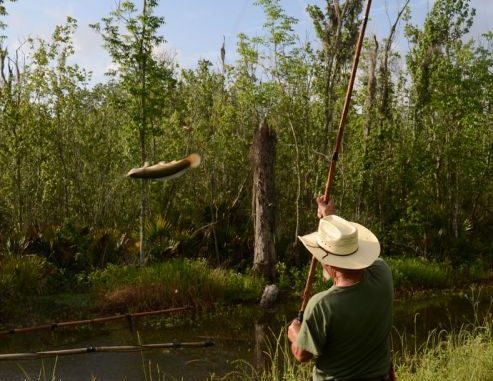
The Lirettes were fishing with permission in canals on private property. But choupique are found virtually everywhere in Louisiana, ranging from swamp and freshwater marsh bayous and canals to the state’s natural lakes and reservoirs from Toledo Bend on down. They are even found in the crystal-clear, fast flowing creeks and rivers of the Florida Parishes.
The Atchafalaya Basin has long been headquarters for choupique populations in Louisiana. But the Basin’s small but stable commercial fishery for the species’ eggs has thinned their numbers there somewhat.
Mike Lirette likes canals, though. “You can find choupique in almost any canal, like those along Highways 65, 61, and 182.” Highway 3127 has good canals off the road too, added nephew Dale.
“The depth of the water isn’t important,” said Mike. “It can be 1 foot deep or it can be 5 feet deep, but I like lots of duckweed and grass in it.
“Without grass, you get too many garfish. I don’t like them. I don’t mess with them.”
They also obviously preferred water that was clear and stained to almost a tea color. In the course of moving from spot to spot to try new areas, they never even bothered to unlimber their poles to fish canals that were muddied by rainwater runoff.
One of the big advantages to choupique fishing is that it is a year-round affair. “They bite 12 months a year, even when it’s ice cold” exclaimed Mike. “Even when the water is very low, they will live in the mud a long while.”
Scientists attribute that to their primitive body arrangement. Like garfish, choupique air bladders have a direct connection to their mouths. When water conditions are so foul that their gills can no longer extract oxygen from the water, they gulp air into their air bladders, which effectively work like primitive lungs.
The pair agreed that while fishing is good all year, the best time is between August and the first cold fronts of fall that are strong enough to cool the water significantly.
“Another good thing is that anyone can catch choupique,” smiled Mike. “You just have to try. You don’t have to be Cajun to catch them.”
Keep in mind that while smaller choupique are very colorful, they must be at least 16 inches long to be retained.


